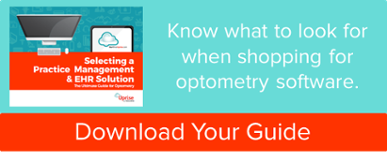3 Tips for Choosing the Right EHR Software For Your Optometric Practice
Whether you’re transitioning from paper-based, or you’re ready to rip and replace your EHR software, selecting a solution that doesn’t work for your practice can cause more problems and frustrations for you, your staff, and your patients.
This post provides tips to prevent buyer’s remorse and the headache of choosing an EHR solution that doesn’t meet your needs.
How to Select the Best EHR Software for Your Practice
Assess Your Needs
Before you start researching EHR software vendors, you need to identify the problems with your current system and evaluate what your practice, staff, and patients need.
If the issues are small, work with your existing EHR provider to see if the features and enhancements are on the roadmap. If not, determine the risks and costs of staying with the provider without the needed features.
Narrow Down Vendors
There are a lot of EHR software vendors in the market. While it may be burdensome to search through long lists of providers, it’s important to have a selection of vendors that are able to meet your needs. Use your list of needs that you created to help you narrow down the list to your top three.
When going through demos, make sure you and your team are asking the right questions to properly vet vendors that don’t provide what your practice needs to be successful.
Choose a System for the Future
In your discussions with vendors, consider if they will be able to work with your future needs and provide the functionality and features that will change as your requirements and the eyecare industry evolves.
Typically, cloud-based EHR software will be able to provide your practice with regular updates and feature enhancements, so the EHR can grow with your practice and the industry. With a good cloud-based system, the updates will take effect without impacting your practice or requiring you to stay late to install the update on each computer.
For more tips on selecting a cloud-based EHR, download our EHR buying guide!

